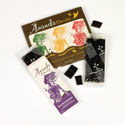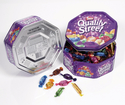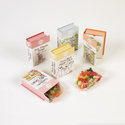Beyond sweet
1 October 2012Confectionery packaging is typically associated with priorities other than sustainability. Paul Gander asks whether this is really the case, and if not, exactly who is this demonstration of responsibility aimed at?
It would be easy to assume that all confectionery packaging tends towards one of two extremes: zany, fun branding for candy targeting younger consumers, and indulgent or luxury associations for products – especially chocolate – aimed at older age groups.
In this simplified analysis, there is little or no room for messages about environmentally responsible packaging.
The implication would be that this is a set of values which might lend themselves to other food and non-food products, but which are not especially relevant to sweet treats.
But peer a little more closely at the huge range of products lined up along the confectionery aisle, and it soon becomes clear that this is not only a simplified version of the truth but an oversimplified one. According to the experts, sustainability in packaging certainly is making itself felt in sweets and chocolate, and will play an even greater role in the future.
At Crown Speciality Packaging, European marketing manager Véronique Curulla agrees with the first half of the ‘two extremes’ premise. “The key aspect for a product aimed at younger consumers will often be brand promotion, such as perceived ‘coolness’, visual appeal or exclusivity,” she says. But she also points out that, along with benefits such as convenience, environmental messages may indeed be a part of the appeal to older consumers.
Tinplate is the chief metal utilised in Crown’s market for larger, gift-style packs for confectionery and chocolate, and the company says that it and its customers have a strong, double-edged sustainability story to tell. “Many packs now carry logos to reinforce the message that metal is very widely recycled,” says Curulla. “And an increasing number of brand-owners are promoting the ‘reusability’ factor, particularly in relation to confectionery and biscuit tins.”
Among those brands, Nestlé’s Quality Street promotes an ‘Enjoy and recycle’ message on its tins, and even goes so far as to suggest ways of reusing them. For several years now, Innovia Films in the UK has been supplying the brand-owner with coloured films made out of its NatureFlex cellulose-based compostable biopolymer. According to Innovia, Nestlé is keen to promote the environmental benefits of both the tin and the individual wrappers.
Growth in organic and fair trade confectionery products, especially chocolate, has acted as a springboard for more sustainable options in the packaging around them. Innovia is one of the suppliers reporting growth among the often smaller businesses in this area.
Product manager Paul Barker cites the example of Dutch company Amigos International. “The customer sought a compostable film to wrap its Ananda range of organic chocolate from Ecuador, and registered its own ‘foil4soil’ trademark to actively promote this fact on the film used to wrap each bar,” he says.
Even where a company favours a more general ‘natural’ positioning, rather than anything tied to specific organic or fair trade origins, this may justify the use of sustainably-sourced packaging. This was the case with the Miss Muffet & Co range of children’s sweets, where product is wrapped in NatureFlex and packaged in a board presentation pack designed for keeping rather than disposal.
But for every brand which trumpets environmental responsibility on its packaging there is one – or more – which chooses not to. As Barker puts it: “Nestlé’s strategy with Quality Street is not the norm. Many who have adopted sustainable materials do not communicate this to their customer base.”
One example of this ‘sustainability by stealth’ would be Cadbury Australia which, says Innovia, uses NatureFlex to wrap its Flake bars, but does not communicate on-pack either that the film is compostable or that it is from renewable resources.
London-based market research company The Big Picture carries out the type of consumer surveys which help to shape retail packaging. When it comes to ‘sustainability’, the company confirms what many of us have suspected all along. While consumers recognise and respond to terms such as ‘recycled’ and may even notice when the size or weight of a pack has been reduced, the term ‘sustainability’ itself means very little to most people.
Big Picture director Suranee Abeysuriya goes even further: “Consumers seem to have been turned off by the dominant culture over recent years of top-down, finger-wagging messages about changing behaviour to be more sustainable. They seem to screen out logos and more rational information on packs.”
Instead, emotive images of people – or animals, of course – are more likely to be associated with ‘green’ values, says the research company.
But evidently, brands are trying to meet internal targets and satisfy stakeholders other than consumers. Abeysuriya goes back to the example of the reusable confectionery tin. The fact that it can have a ‘second life’ once the sweets or chocolates have all disappeared, she says, might not be thought of as ‘sustainable’ by the consumer. But it means that the brand-owner can indeed put a tick in the sustainability box.
Thanks to the growing sophistication of Corporate Social Responsibility (CSR) strategies, an individual pack may still be contributing to overall targets, even when no claims appear on the label. The prime example of this is packaging reduction, with retailers such as Marks & Spencer (M&S) in the UK – joined by ever-larger numbers of brand-owners – declaring in 2011 a 26% cut in the weight of non-glass packaging compared with 2006-2007.
Both metal and board packaging have made significant contributions to this weight reduction trend. But both materials sectors tread carefully, too. A presentation tin or box is not the same as a drinks can or tea carton: both are likely to aspire to some sort of perceived value or premium association.
These reductions are often incremental and highly technical. At Stora Enso, Germany, sales director for consumer board Wilfried Schmahl explains that on the company’s CKB coated kraft board, for instance, grams per square metre have been reduced while maintaining the stiffness and – critically – thickness of the material.
“Thanks to adaptations in our fibre technology, balancing longer and shorter fibres, and in our processes, we’ve cut weights from 275g/m2 to 255g/m2, while maintaining these key parameters as they are,” he reports.
Another increasingly important measure of sustainability in paper and board is the use of responsible forestry accreditation systems. Challenges here include the limited availability of certified raw materials. As part of its Plan A CSR strategy, for instance, M&S has been implementing a policy of sourcing only Forestry Stewardship Council (FSC) certified board for food. But its latest report on Plan A admits that insufficient raw materials meant it could not extend this undertaking to timber products.
As Schmahl at Stora Enso points out, historically many retailers have insisted on accreditation either through the FSC or the Programme for the Endorsement of Forest Certification (PEFC). “Now, increasingly, many retailers around Europe are saying that they will accept both FSC and PEFC board,” he says. “Discounters such as Lidl and Aldi in Germany have led the way, but more decision-makers are following their lead.”
This, in theory, allows confectionery brands and retailers to maintain an ethical position while neither hitting availability problems nor interfering with the board making and converting efficiencies required in the busy run-up to the Christmas and Easter periods.
When it comes to plastics, the sustainable equivalent of forestry accreditation must be recycled content. But since there is no international certification system for this, it is up to individual manufacturers how – or whether – they communicate such content.
Staeger Clear Packaging in the UK, part of the Swiss Staeger group, says that demand for its recyClear polyethylene terephthalate (PET) sheet with post-consumer recycled (PCR) content now accounts for 90% of the company’s turnover. “We guarantee that our recycled PET contains a minimum of 50% PCR,” says sales director Jon Bullimore.
Applications of Staeger’s diecut, printable sheet in the confectionery sector typically include Easter eggs and other seasonal hollow chocolate figures.
“Statements about what the material consists of, and the fact that it can be recycled, are increasingly a part of the artwork that we handle directly ourselves,” he says. But this type of detail is still ‘back-of-pack’ information rather than any sort of front-of-pack claim.
What PCR plastics content also has in common with sustainable forestry products is limited availability. As a group, Staeger sources much of its PCR in Germany and Italy. “But even though we do offer a 100%-PCR sheet, eventually, you’re going to run out.” Adding another dimension to the term, he adds: “It’s just not sustainable.”
There have been other setbacks on the road to sustainability, not least the panic over mineral oil migration from recycled fibre over the last couple of years. This has had a limited impact on confectionery packaging, which generally requires virgin fibre for food contact packaging. In fact, in the longer term, recycled grades may benefit from the greater availability of coated, barrier boards, as suppliers work to reassure their customers.
Though not intended to provide this specific type of barrier, Stora Enso for instance already offers ‘bio coating’ of board with a combination of three different industrially-compostable biopolymers. “It has been applied to drinking cups for fast food outlets,” says Schmahl. “Now we’re also offering it for cartons.”
But both Stora Enso and Innovia admit that cost can be an obstacle when it comes to the wider use of biopolymers. “If sustainable packaging costs decrease, then we may see a faster adoption of these technologies,” says Barker.
As volumes and economies of scale progress, greater affordability seems likely. “Sustainable options may be adopted in a wider range of confectionery sub-segments, not only for ‘green’ reasons, but as the technical functionality of those materials increases,” he adds.
Some of the confectionery and biscuit tins produced by Crown Speciality Packaging Crown 1 Crown consumer packs Crown 2 Compostable film from Innovia chosen to wrap organic chocolate range Innovia ‘Enjoy and recycle’ message comes with Quality Street Quality Street Film and board combination – the choice for this Miss Muffet & Co range Miss Muffet Staeger’s PET sheet chosen for liquorice... Staeger 1 ...and for chocolate Staeger 2 Chocolate packaged in board supplied by Stora Enso Stora Enso 1 Stora Enso pack for chocolates Stora Enso 2










